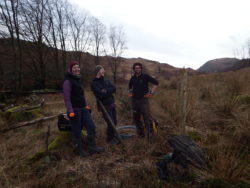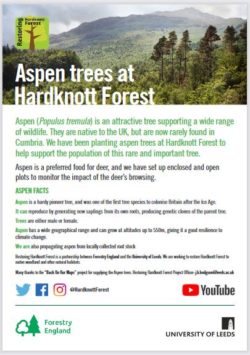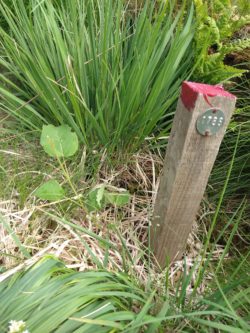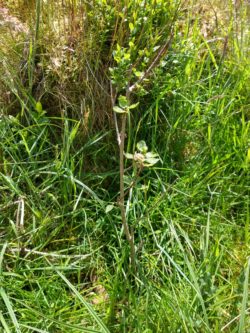Aspen monitoring
As a rare and ecologically important species, we are planting and monitoring aspen around our site. We're also taking the opportunity to try different types of protection from browsing (including planting with no protection), and we are trialling the planting of root sections, as well as saplings.
Revisit this page for updates, or sign up to the newsletter here.
For an in-depth background article on aspen, read our blog here.
Duddon Monitoring Site
Our main aspen monitoring site runs alongside the River Duddon, within a recently clearfelled area. Deer are known to browse here, and as aspen are one of the most palatable tree species to herbivores, we are making use of these factors to monitor the effect that browsing can have. Five 10m by 10m fenced exclosures were constructed by project staff, each was planted with 9 saplings and all saplings were plotted by GPS, mapped and measured. This process was repeated with another five unfenced 10m by 10m plots (i.e no protection from browsing).
In addition we have planted about 50 saplings in two different tube designs, a mixture of 60cm cardboard tubes and 1.2m plastic tubes. See the map and key below for more details.
This will provide useful information into:
1) the behaviour of the deer at Hardknott
2) the effect browsing has on aspen saplings
3) the effectiveness of different methods of tree protection
Tagged aspen monitoring
At two other locations we have planted areas with 20 aspen saplings, each one having a GPS location and tree tag (see picture).
Starting in March 2020, these have been measured and monitored each quarter. Data is being recorded on how much growth there has been, and the percentage of saplings which have been browsed. Not surprisingly mean growth is varying a lot with the seasons (the highest maximum growth value being 28cm, mean value 2.8cm). It will be valuable to track browsing over time: it has varied so far from 2.5% of saplings browsed, up to 60%. Some of this has been attributed to voles. Will deer take more interest as the saplings grow larger, will this affect survival rate as well as growth, is there a variation with locality? Keep an eye out for updates.
Root cuttings
Aspen often reproduce vegetatively from their own root systems. We can make use of this trait to increase aspen at Hardknott by collecting and planting root cuttings. Last Autumn we planted ten root sections, collected from aspen at a farm further down the Duddon Valley. These have recently been inspected, and although it's early days most seem to be thriving.
See our November newsletter for more information on our aspen root collection.
And finally, a video of aspen in the breeze at Hardknott Forest.






